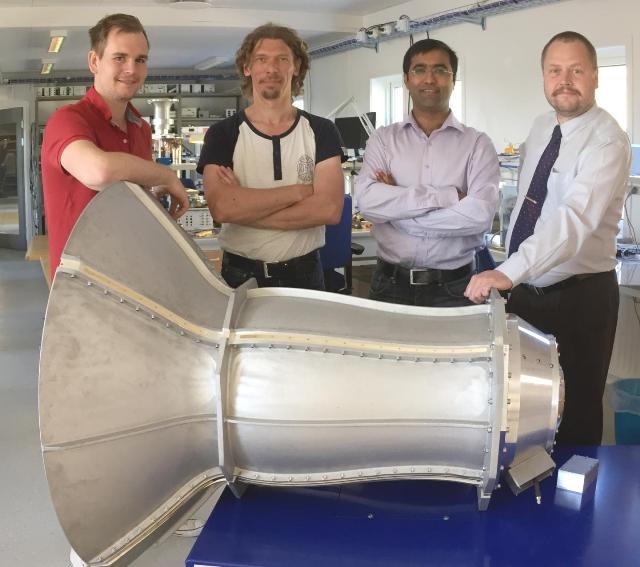Jun 17 2016
Sweden’s biggest contribution yet to the world’s biggest radio telescope, the Square Kilometre Array (SKA), has passed a major milestone. An advanced – and beautiful – feed horn developed at Chalmers University of Technology, has been delivered for testing in Canada.
 The Band 1 feed in the electronics lab at Onsala Space Observatory. Standing behind the feed horn from the left: Joel Schleeh (Low Noise Factory) with Onsala Space Observatory engineers Magnus Dahlgren, Bhushan Billade (technical project manager) and Jens Dahlström. (CREDIT: SKA Organisation)
The Band 1 feed in the electronics lab at Onsala Space Observatory. Standing behind the feed horn from the left: Joel Schleeh (Low Noise Factory) with Onsala Space Observatory engineers Magnus Dahlgren, Bhushan Billade (technical project manager) and Jens Dahlström. (CREDIT: SKA Organisation)
The sensitive feed horn – with an opening almost one metre across, and weighing almost 100 kilograms – will help astronomers to tell the history of the universe. Built at Onsala Space Observatory and now delivered for testing in Canada, it will eventually be fitted on each of the 133 dish antennas at the SKA's South African site in the first phase of deployment of the SKA.
Construction of the SKA is scheduled to begin only a few years from now, in both South Africa and Australia. Sweden, represented by Onsala Space Observatory at Chalmers University of Technology, has been part of the project’s design phase since 2012.
The telescope's instrument in South Africa will be made up of hundreds of 15-metre dish antennas, located in the remote Karoo Desert in Northern Cape province. Currently intensive work is underway all over the world to develop and test the telescope’s components. Antennas, feed horns and receivers are all needed to register faint radio waves from the cosmos.
SKA will be able to make measurements which will surpass all of today’s radio telescopes. Among many other projects, astronomers hope to be able to map out how the first galaxies were formed, over 13 billion years ago.
”The feed horn is our biggest and most important contribution yet to the SKA. Each antenna will have a horn like this, and each antenna’s feed horn is one of its most important components. In it we combine nanotechnology with precision instrumentation”, says Miroslav Pantaleev, leader for the SKA technology team in Onsala.
Each of the telescope’s dishes collects faint radio signals from space. The dish’s feed horn, combined with an advanced amplifier, then prepares the radio signal so that it can be analysed by astronomers. The horn itself is an impressive combination of mechanical engineering and radio optical design – all with the aim of being maximally sensitive but also cost-effective for mass production. It has a so-called quadridge design, with four ridges on the inside, developed by Onsala Space Observatory specifically for SKA from an earlier design by the South African company EMSS Antennas.
The feed horn has been developed for the longest wavelengths that SKA’s dish antennas will be sensitive to, between 350 and 1050 MHz (wavelengths from 30-85 cm; Band 1).
It will now be tested on an antenna prototype built for SKA at the Canadian National Research Council's Dominion Radio Astrophysical Observatory (DRAO) facility near Penticton, British Columbia, Canada.
The amplifiers for the feed horn have been specially developed for this project by the Gothenburg-based company Low Noise Factory in collaboration with Onsala Space Observatory and the Gigahertz Centre at Chalmers. A paper describing the work on the amplifiers was presented on 26 May at the International Microwave Symposium 2016 in San Francisco, USA.
Joel Schleeh, engineer at Low Noise Factory, explains.
“The amplifier uses nanotechnology to amplify the radio waves with as little noise as possible. Normally, noise reduction means we have to cool the amplifier down to a few degrees above absolute zero. Instead, our bespoke amplifier is integrated directly in the feed horn, which means we can retain the telescope’s sensitivity without using any cooling at all. For SKA this could mean huge savings in energy, maintenance and investment”, he says.
John Conway is director of Onsala Space Observatory.
”Our delivery of this feed horn shows that Sweden is making a difference in the international SKA project. We are setting the scene for new insights about our universe, and our origins in the cosmos. At the same time we are creating new opportunities for cutting-edge technology from Sweden to reach the rest of the world”, he says.